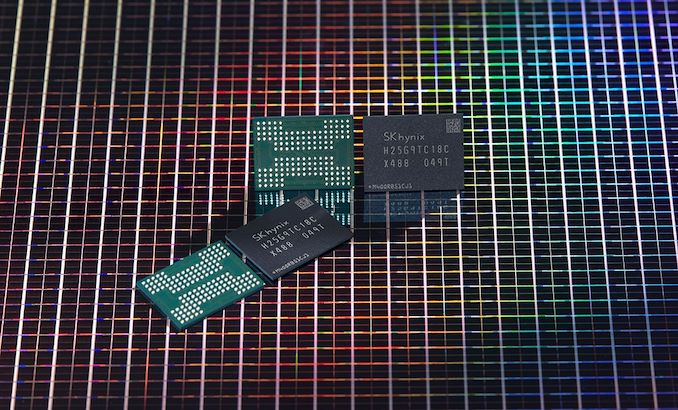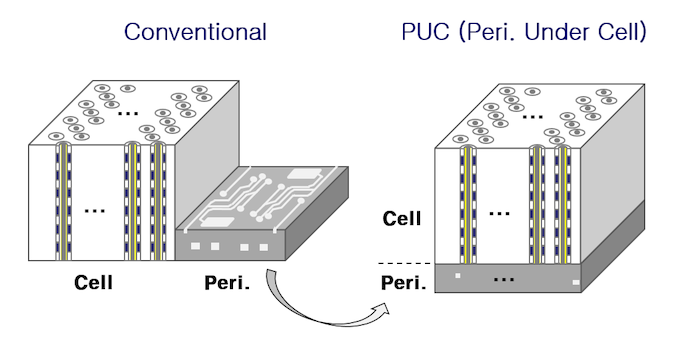SK Hynix Announces 176-Layer 3D NAND
by Billy Tallis on December 7, 2020 8:00 AM EST
SK hynix has announced their latest generation of 3D NAND, now featuring 176 layers of charge trap flash memory cells. SK hynix is the second NAND manufacturer to reach this layer count, following Micron's announcement that their 176L NAND was starting to ship in Crucial-branded products.
This is SK hynix's third generation to feature their Periphery under Cell (PUC) design to reduce die size by placing peripheral logic under the memory cell array, similar to Intel and Micron's CMOS Under Array design. (SK hynix refers to the combination of this die layout and their charge trap flash cells as "4D NAND".) Changes with this generation include a 35% increase in bit productivity (only slightly less than theoretically possible with the jump from 128 to 176 layers) and a 20% increase in cell read speed. The maximum IO speed between NAND dies and the SSD controller has been increased from 1.2GT/s for their 128L NAND to 1.6GT/s for the 176L NAND.
SK hynix has started sampling a 512Gbit TLC part to SSD controller companies for developing compatible firmware. SK hynix plans to initially use their 176L NAND for mobile products (ie. UFS modules) which will offer 70% faster read speeds and 35% faster write speeds, due to be introduced around the middle of next year. The mobile products will then be followed up by consumer and enterprise SSDs. SK hynix also plans to introduce 1Tbit dies based on their 176L process.
Based on this announcement, it appears that SK hynix will be fairly competitive during the upcoming generation of 3D NAND. They may be running a bit behind Micron's schedule, but Micron has been pursuing an unusually quick transition to 176L after using their 128L generation as a low-volume test vehicle to work out any issues resulting from their switch from floating gate to charge trap cell design. Meanwhile, Intel's 144L NAND should be arriving early next year, and Kioxia/Western Digital 112L NAND is due to show up any day now. Samsung's 128L NAND started shipping a few months ago in the 980 PRO. While they have not officially announced specs for their next generation, it is expected to go into production next spring with a layer count in the neighborhood of 176L, and to be Samsung's first generation to use string stacking—a technique their competitors all had to adopt while layer counts were in the 64-96L range.
Related Reading:
- Micron Announces 176-layer 3D NAND
- SK Hynix to Buy Intel’s NAND Memory Business For $9 Billion
- The Best NVMe SSD for Laptops and Notebooks: SK hynix Gold P31 1TB SSD Reviewed
- Western Digital and Kioxia Announce BiCS5 112-Layer 3D NAND
Source: SK hynix











29 Comments
View All Comments
Kurosaki - Monday, December 7, 2020 - link
I can almost smell those 8TB SSD's for 100usd, any year now.https://i.imgflip.com/cloo6.jpg
jeremyshaw - Monday, December 7, 2020 - link
Probably using OLC... using octuple layer cells. Performance worse than 1999 32MB flash drive when out of SLC caching mode. TBW? More like GBW! Even WORM usecases will have enough read disruption to meaningfully decrease the lifespan of the flash!29a - Monday, December 7, 2020 - link
What would we do without the wisdom of armchair electrical engineers?jeremyshaw - Monday, December 7, 2020 - link
We'd wryly post quips on news comments, probably.Oxford Guy - Monday, December 14, 2020 - link
Fill lousy QLC drives with games equally inferior?deil - Monday, December 7, 2020 - link
With OLC we would have 30 TB driver to ride now. They won't make it if it won't survive at least 100 writes, (more like 500) so 3PBW+. good luck writing that.You really want your PC to last for decades or are you ok with 5 years like 80% of users do use it?
Then go back to your core 2 duo and magnetic drive and stop trying to stop progress.
waterdog - Monday, December 7, 2020 - link
Building products with inferior performance and inferior longevity is not progress.inighthawki - Monday, December 7, 2020 - link
Not all applications require the fastest performance characteristics. And for the vast vast majority of users, the drive endurance of QLC NAND is well within reason. Very very few people are writing hundreds of GB of data to their SSD every day for years straight.Spunjji - Wednesday, December 9, 2020 - link
It absolutely is progress if it makes them so cheap that they become mass-market, and they're still fast and long-lived enough for said mass-market.Seriously this is pretty basic economics. It's not all about harder, better, faster, stronger. There's a reason Concorde and the A380 were both commercial failures, despite pushing back the technological boundaries of air travel (speed, capacity).
at_clucks - Friday, December 11, 2020 - link
Other than the 737 MAX basically all airplanes flying today are up to the standards of carrying passengers safely. In order for the average user to enjoy the hypothetical OLC we have to really drop the standards for what it means to keep your data safe.The data is probably worth more than the drive itself so making them mass market and cheaper just makes losing your data cheaper if you don't fix the reliability aspect.